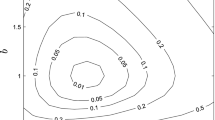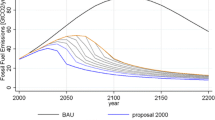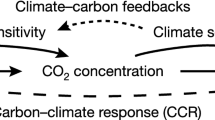Abstract
Economic evaluation of climate policy traditionally treats uncertainty by appealing to expected utility theory. Yet our knowledge of the impacts of climate policy may not be of sufficient quality to be described by unique probabilistic beliefs. In such circumstances, it has been argued that the axioms of expected utility theory may not be the correct standard of rationality. By contrast, several axiomatic frameworks have recently been proposed that account for ambiguous knowledge. In this paper, we apply static and dynamic versions of a smooth ambiguity model to climate mitigation policy. We obtain a general result on the comparative statics of optimal abatement and ambiguity aversion, and then extend our analysis to a more realistic, dynamic setting, where we introduce scientific ambiguity into the well-known DICE model of the climate-economy system. For policy-relevant exogenous mitigation policies, we show that the value of emissions abatement increases as ambiguity aversion increases, and that this ‘ambiguity premium’ can in some plausible cases be very large. In these cases the effect of ambiguity aversion on welfare is comparable to that of other much studied welfare parameters. Thus ambiguity aversion may be an important neglected aspect of climate change economics, and seems likely to provide another argument for strong abatement policy.
Similar content being viewed by others
References
Ackerman F, Stanton EA, Bueno R (2010) Fat tails, exponents, and extreme uncertainty: simulating catastrophe in DICE. Ecol Econ 69(8): 1657–1665
Anscombe FJ, Aumann RJ (1963) A definition of subjective probability. Ann Math Stat 34(1): 199–205
Arrow KJ, Hurwicz L (eds) (1977) An optimality criterion for decision-making under ignorance. In: Studies in resource allocation processes, p 482. Cambridge University Press, Cambridge
Athanassoglou S, Xepapadeas A (2012) Pollution control with uncertain stock dynamics: when, and how, to be precautious. J Environ Econ Manag 63(3): 304–320
Bassett GW, Koenker R, Kordas G (2004) Pessimistic portfolio allocation and choquet expected utility. J Financ Econom 2(4): 477–492
Binmore K. (2009) Rational decisions. Princeton University Press, Princeton, NJ
Bossaerts P, Ghirardato P, Guarnaschelli S, Zame WR (2010) Ambiguity in asset markets: theory and experiment. Rev Financ Stud 23(4):1325–1359
Cai Y, Judd KL, Lontzek TS (2012) DSICE: a dynamic stochastic integrated model of climate and economy. SSRN working paper
Camerer C (1999) Ambiguity-aversion and non-additive probability: experimental evidence, models and applications. In: Luini L (eds) Uncertain decisions: bridging theory and experiments. Kluwer, Dordrecht, pp 53–80
Dasgupta P (2008) Discounting climate change. J Risk Uncertain 37(2): 141–169
Dow J, da Costa Werlang SR (1992) Uncertainty aversion, risk aversion, and the optimal choice of portfolio. Econometrica 60(1): 197–204
Ellsberg D (1961) Risk, ambiguity, and the Savage axioms. Q J Econ 75(4): 643–669
Frame DJ, Faull NE, Joshi MM, Allen MR (2007) Probabilistic climate forecasts and inductive problems. Philos Trans R Soc A Math Phys Eng Sci 365(1857): 1971–1992
Ghirardato P, Maccheroni F, Marinacci M (2004) Differentiating ambiguity and ambiguity attitude. J Econ Theory 118(2): 133–173
Gilboa I (2009) Theory of decision under uncertainty, 1st edn. Cambridge University Press, Cambridge, MA
Gilboa I, Postlewaite A, Schmeidler D (2009) Is it always rational to satisfy Savage’s axioms?. Econ Philos 25(3): 285–296
Gilboa I, Postlewaite AW, Schmeidler D (2008) Probability and uncertainty in economic modeling. J Econ Perspect 22(3): 173–188
Gilboa I, Schmeidler D (1989) Maxmin expected utility with non-unique prior. J Math Econ 18(2): 141–153
Gilboa I, Schmeidler D (1995) Case-based decision theory. Q J Econ 110(3): 605–639
Gollier C (2001) The economics of risk and time. MIT Press, Cambridge
Gollier C (2009) Portfolio choices and asset prices: the comparative statics of ambiguity aversion. IDEI working paper 357. http://idei.fr/display.php?a=4812
Gollier C, Gierlinger J (2008) Socially efficient discounting under ambiguity aversion. IDEI working paper 561. http://idei.fr/display.php?a=9848
Gonzalez F (2008) Precautionary principle and robustness for a stock pollutant with multiplicative risk. Environ Resour Econ 41(1): 25–46
Hansen LP, Sargent TJ (2007) Robustness. Princeton University Press, Princeton, NJ
Heal G (2009) Climate economics: a meta-review and some suggestions for future research. Rev Environ Econ Policy 3(1): 4–21
Henry C, Henry M (2002) Formalization and application of the precautionary principle. Columbia University Department of Economics discussion paper series. http://www.columbia.edu/cu/economics/discpapr/DP0102-22.pdf
Herstein IN, Milnor J (1953) An axiomatic approach to measurable utility. Econometrica 21(2): 291–297
Hoeting JA, Madigan D, Raftery AE, Volinsky CT (1999) Bayesian model averaging: a tutorial. Stat Sci 14(4): 382–401
Hope C (2006) The marginal impact of CO2 from PAGE2002: an integrated assessment model incorporating the IPCC’s five reasons for concern. Integr Assess 6(1):19–56
Jouzel J, Masson-Delmotte V, Cattani O, Dreyfus G, Falourd S, Hoffmann G, Minster B, Nouet J, Barnola JM, Chappellaz J, Fischer H, Gallet JC, Johnsen S, Leuenberger M, Loulergue L, Luethi D, Oerter H, Parrenin F, Raisbeck G, Raynaud D, Schilt A, Schwander J, Selmo E, Souchez R, Spahni R, Stauffer B, Steffensen JP, Stenni B, Stocker TF, Tison JL, Werner M, Wolff EW (2007) Orbital and millennial Antarctic climate variability over the past 800,000 years. Science 317(5839): 793–796
Ju N, Miao J (2012) Ambiguity, learning, and asset returns. Econometrica 80(2): 559–591
Karp L, Zhang J (2006) Regulation with anticipated learning about environmental damages. J Environ Econ Manag 51(3): 259–279
Keller K, Bolker BM, Bradford DF (2004) Uncertain climate thresholds and optimal economic growth. J Environ Econ Manag 48(1): 723–741
Kelly DL, Kolstad CD (1999) Bayesian learning, growth, and pollution. J Econ Dyn Control 23(4): 491–518
Klibanoff P, Marinacci M, Mukerji S (2005) A smooth model of decision making under ambiguity. Econometrica 73(6): 1849–1892
Klibanoff P, Marinacci M, Mukerji S (2009) Recursive smooth ambiguity preferences. J Econ Theory 144(3): 930–976
Knight F (1921) Risk, uncertainty, and profit. Houghton Mifflin, New York
Knutti R (2010) The end of model democracy?. Clim Change 102(3): 395–404
Knutti R, Furrer R, Tebaldi C, Cermak J, Meehl GA (2010) Challenges in combining projections from multiple climate models. J Clim 23(10): 2739–2758
Kreps DM, Porteus EL (1978) Temporal resolution of uncertainty and dynamic choice theory. Econometrica 46(1): 185–200
Lange A, Treich N (2008) Uncertainty, learning and ambiguity in economic models on climate policy: some classical results and new directions. Clim Change 89(1): 7–21
Lemoine D, Traeger CP (2012) Tipping points and ambiguity in the Economics of climate change. NBER working paper no 18230
Lenton TM, Held H, Kriegler E, Hall JW, Lucht W, Rahmstorf S, Schellnhuber HJ (2008) Tipping elements in the Earth’s climate system. Proc Natl Acad Sci 105(6): 1786–1793
Maccheroni F, Marinacci M, Rustichini A (2006) Ambiguity aversion, robustness, and the variational representation of preferences. Econometrica 74(6): 1447–1498
Manne A, Richels R (1992) Buying greenhouse insurance: the economic costs of CO2. The MIT Press, Cambridge, MA
McJeon HC, Clarke L, Kyle P, Wise M, Hackbarth A, Bryant BP, Lempert RJ (2011) Technology interactions among low-carbon energy technologies: what can we learn from a large number of scenarios?. Energy Econ 33(4): 619–631
Meinshausen M, Meinshausen N, Hare W, Raper SCB, Frieler K, Knutti R, Frame DJ, Allen MR (2009) Greenhouse-gas emission targets for limiting global warming to 2C. Nature 458(7242): 1158–1162
Nordhaus WD (2008) A question of balance. Yale University Press, New Haven, CT
Savage LJ (1954) The foundations of statistics. Wiley, London
Schmeidler D (1989) Subjective probability and expected utility without additivity. Econometrica 57(3): 571–587
Slovic P, Tversky A (1974) Who accepts Savage’s axiom?. Behav Sci 19(6): 368–373
Smith LA (2002) What might we learn from climate forecasts? Proc Natl Acad Sci USA 99(Suppl 1): 2487–2492
Smith LA (2007) Chaos: a very short introduction, vol 159. Oxford University Press, Oxford
Stainforth DA, Allen MR, Tredger ER, Smith LA (2007) Confidence, uncertainty and decision-support relevance in climate predictions. Philos Trans R Soc A Math Phys Eng Sci 365(1857): 2145–2161
Stern N (2008) The economics of climate change. Am Econ Rev 98(2): 1–37
Stern NH (2007) The economics of climate change: the Stern review. Cambridge University Press, Cambridge
Tebaldi C, Knutti R (2007) The use of the multi-model ensemble in probabilistic climate projections. Philos Trans R Soc A Math Phys Eng Sci 365(1857): 2053–2075
Tol R (1997) On the optimal control of carbon dioxide emissions: an application of FUND. Environ Model Assess 2(3): 151–163
Traeger CP (2009) Recent developments in the intertemporal modeling of uncertainty. Annu Rev Resour Econ 1(1): 261–286
von Neumann J, Morgenstern O (1944) Theory of games and economic behaviour. Princeton University Press, Princeton, NJ
Weitzman ML (1976) On the welfare significance of national product in a dynamic economy. Q J Econ 90(1): 156–162
Weitzman ML (2007) A review of The Stern review on the economics of climate change. J Econ Lit 45(3): 703–724
Weitzman ML (2009) On modeling and interpreting the economics of catastrophic climate change. Rev Econ Stat 91(1): 1–19
Weitzman ML (2012) GHG targets as insurance against catastrophic climate damages, ghg targets as insurance against catastrophic climate damages. J Public Econ Theory 14(2): 221–244
Author information
Authors and Affiliations
Corresponding author
Additional information
An earlier version of this paper appeared as NBER Working Paper no. 16050. We thank Martin Weitzman, Christian Traeger, Larry Karp, Cameron Hepburn, seminar participants at Columbia, Harvard, Berkeley, Stanford, AERE, EAERE, and the 12th Occasional California Workshop on Environmental Economics, and two anonymous referees for helpful comments. We are grateful to Malte Meinshausen for supplying us with the empirical estimates of the climate sensitivity distributions.
Rights and permissions
About this article
Cite this article
Millner, A., Dietz, S. & Heal, G. Scientific Ambiguity and Climate Policy. Environ Resource Econ 55, 21–46 (2013). https://doi.org/10.1007/s10640-012-9612-0
Accepted:
Published:
Issue Date:
DOI: https://doi.org/10.1007/s10640-012-9612-0




